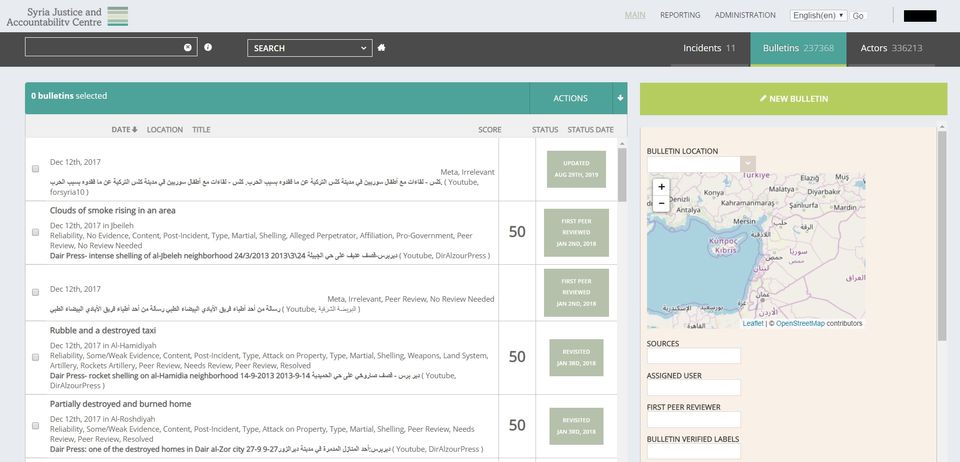
SJAC's Database: How SJAC is Using Technology to Transform the Field of Human Rights Documentation
The Syrian conflict has been documented by civilians and eyewitnesses at an unprecedented scale. Perpetrators, victims, and eye-witnesses have captured millions of videos and images, many of which have been disseminated in real-time across the internet. The ability to capture and publicize such massive amounts of documentation has profound implications for the human rights sphere, presenting new opportunities and also risks in the documentation of war crimes. Despite the vast potential of online documentation, many NGOs do not fully utilize social media content due to the overwhelming scope of the data that is available. A 2012 report by the Center for Library Resources found that “significant human rights documentation is being at risk or is being lost all together” because organizations and investigators do not have the ability to “adequately manage and maintain” digital content.
The Syria Justice and Accountability Centre was created in 2012 with the hope of filling this gap with regard to the Syrian conflict. Since its creation, the organization has devoted a significant portion of its resources to building a database of documentation from social media and other digital sources as well as documenters working on the ground. To date, SJAC’s database has preserved around 1.8 million pieces of online data on the Syrian conflict, and its team of data analysts has assessed and labeled more than 180,000 videos.
Videos processed in 2019. In 2019, SJAC’s data analysis team analyzed on average 8,560 videos per month.
“There are millions of pieces of documentation that were collected during the Syrian conflict,” says Ashraf*, SJAC’s Senior Data Analyst,” it is almost impossible to find what you are looking for if you are a prosecutor, if you need more information on specific incidents. This work is organizing and cataloging this data in a way that makes it accessible to anyone who wants to reach specific info.”
Screenshots from SJAC’s database
To organize the data, SJAC’s team has worked to develop a robust classification system. Each piece of documentation is tagged and labeled with source information, temporal markers, geographical data, information about types and methods of violations, and actor identifiers with respective roles. Each piece of documentation also undergoes a multi-tiered reliability assessment. The processed data is organized into relational database, which allows users to identity and view relationships between related data. For example, documentation from different sources can be linked to create specific incidents, helping researchers expand their contextual understanding of specific events and cross corroborate details. In addition, SJAC’s analyst team is also working to create actors list which links individual actors to entities in which they appear. This can help link perpetrators to their crimes or link victims to their perpetrators.
All SJAC analysts must complete a two to three-month training program before they work on SJAC’s live server. Ashraf notes that, to ensure objectivity, analysts are taught to analyze information through a ‘closed universe’ lens—looking only at the information available in each video. In addition, all analysts are native Arabic speakers, and most are Syrians with in depth knowledge of local nuances, such as local dialects, geography, and culture.
Geolocations of data analyzed in each province.
Videos in SJAC’s database already proven helpful in identifying information for investigations. So far, 2,686 have been identified as “high priority”, containing critical evidence of violations. In several instances, SJAC has utilized its database to find relevant data in response to requests made by national prosecutors in Europe. SJAC also shares its data with the International, Impartial and Independent Mechanism (IIIM), a United Nations mechanism mandated to assist with the investigation and prosecution of persons allegedly responsible for the most series crimes in Syria. Beyond criminal prosecutions, SJAC works with the belief that the preservation and analysis of digital data will be critical to a range of transitional justice efforts in the future, including truth-telling and memorialization.
Alleged perpetrators in videos analyzed by SJAC analysts. Numbers represent each video in which the parties were labeled as potential perpetrators. Videos are currently being analyzed chronologically. Thus, videos containing ISIS violations are currently low because videos post 2014 have yet to be processed. Due to their highly graphic nature, SJAC also plans to have videos containing violations carried out by ISIS analyzed at a slower rate to minimize secondary trauma to analysts. Number of IHL violations identified in analyzed data.
Given the sheer scale of the data which must be processed, and the ongoing nature of the conflict, the project is expected to continue for several years. The nature of the work has presented unique risks. “The biggest challenge for our analysts is dealing with graphic videos,” Ashraf says, “we have a considerable number.” To address the secondary trauma which may arise from repeated exposure to graphic content, SJAC continues to develop and provide a wide array of psychosocial support tools for its team. It also works to ensure that no analyst is exposed to a large number of graphic images at one time. Analysis of videos with the most potential for graphic content—those created by ISIS, for example—is purposely spread across a longer space of time.
“Even though full justice seems to be far,” says Ashraf, “I think one of the big goals of the project is truth. Having this information recorded and accessible, it will help in the future pursuit of truth.”
*Name changed to protect the identity of the analyst
For more information or to provide feedback, please contact SJAC at [email protected] and follow us on Facebook and Twitter.